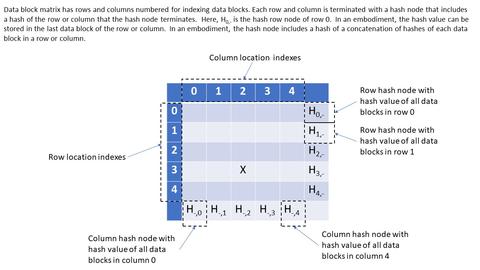A Data Structure for Integrity Protection with Erasure Capability
Published Patent Application Number: US20200348841A1
Problem
patent description
This invention is a data structure, which can be referred to as a block matrix, that supports the ongoing addition of hash-linked records while also allowing the deletion of arbitrary records, preserving hash-based integrity assurance that other blocks are unchanged. The block matrix data structure may have utility for incorporation into applications requiring integrity protection that currently use permissioned blockchains. This capability could for example be useful in meeting privacy requirements such as the European Union General Data Protection Regulation (GDPR), which requires that organizations make it possible to delete all information related to an individual, at that person's request. Also, it can be implemented in a decentralized system to provide data replication among peers.

Invention
Provided is a process including: initializing a data block matrix; making supra-diagonal nodes that include at most one more node than sub-diagonal nodes; making a hash nodes with a hash sequence length that is proportional to a number of nodes in the row or column of nodes in which the hash node is arranged; and writing data blocks in nodes of the data block matrix such that a number of data blocks in nodes in the data block matrix is less than (N2−N) for N number of nodes in the data block matrix, wherein the data block matrix has dispersed data blocks.
Features
Blockchain and other forms of distributed ledger technology are increasingly popular for data management applications, because they provide cryptographically-based integrity guarantees. However, existing blockchains and distributed ledger technology do not allow for changes or deletions of information, which can prevent their use in privacy-sensitive applications, or systems that must adhere to privacy regulations such as GDPR.

